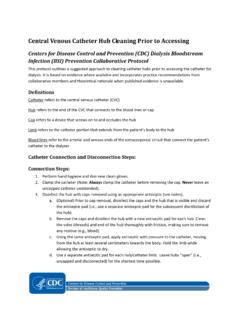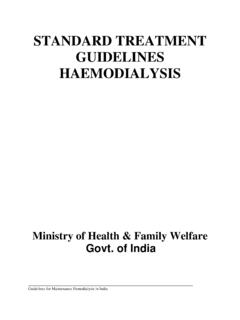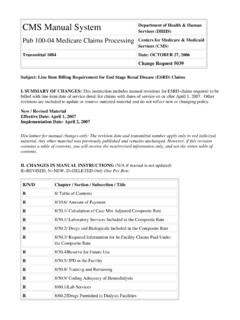Transcription of Hemodialysis Central Venous Catheter Scrub-the-Hub …
1 Hemodialysis Central Venous Catheter Scrub-the-Hub Protocol This protocol outlines a suggested approach to preparing 4. Always handle the Catheter hubs aseptically. Once Catheter hubs prior to accessing the Catheter for Hemodialysis . disinfected, do not allow the Catheter hubs to touch It is based on evidence where available and incorporates nonsterile surfaces. theoretical rationale when published evidence is unavailable. 5. Attach sterile syringe, unclamp the Catheter , withdraw blood, and flush per facility protocol.
2 Definitions: 6. Repeat for other limb (this might occur in parallel). Catheter refers to a Central Venous Catheter (CVC) or a 7. Connect the ends of the blood lines to the Catheter Central line aseptically. Hub refers to the end of the CVC that connects to the 8. Remove gloves and perform hand hygiene. blood lines or cap Cap refers to a device that screws on to and occludes Disconnection Steps: the hub 1. Perform hand hygiene and don new clean gloves. Limb refers to the Catheter portion that extends from the patient's body to the hub 2.
3 Clamp the Catheter (Note: Always clamp the Catheter before disconnecting. Never leave an uncapped Catheter Blood lines refer to the arterial and Venous ends of the unattended). extracorporeal circuit that connect the patient's Catheter 3. Disinfect the Catheter hub before applying the new cap to the dialyzer using an appropriate antiseptic (see notes). a. (Optional) Disinfect the connection prior to disconnection. If this is done, use a separate antiseptic Catheter Connection and Disconnection pad for the subsequent disinfection of the hub.
4 Steps: b. Disconnect the blood line from the Catheter and Connection Steps disinfect the hub with a new antiseptic pad. Scrub 1. Perform hand hygiene and don new clean gloves. the sides (threads) and end of the hub thoroughly with friction, making sure to remove any residue 2. Clamp the Catheter (Note: Always clamp the Catheter ( , blood). before removing the cap. Never leave an uncapped Catheter unattended). c. Use a separate antiseptic pad for each hub. Leave hubs open ( , uncapped and disconnected) for the 3. Disinfect the hub with caps removed using an appropriate shortest time possible.
5 Antiseptic (see notes). 4. Always handle the Catheter hubs aseptically. Once a. (Optional) Prior to cap removal, disinfect the disinfected, do not allow the Catheter hubs to touch caps and the part of the hub that is accessible and nonsterile surfaces. Hold the Catheter until the antiseptic has discard the antiseptic pad ( , use a separate antiseptic dried. pad for the next step). 5. Attach the new sterile caps to the Catheter aseptically. b. Remove the caps and disinfect the hub with a new Use caution if tape is used to secure caps to the Catheter antiseptic pad for each hub.
6 Scrub the sides (threads) (see notes). and end of the hub thoroughly with friction, making sure to remove any residue ( , blood). 6. Ensure that Catheter is still clamped. 7. Remove gloves and perform hand hygiene. c. Using the same antiseptic pad, apply antiseptic with friction to the Catheter , moving from the hub at least several centimeters towards the body. Hold the limb while allowing the antiseptic to dry. d. Use a separate antiseptic pad for each hub/. Catheter limb. Leave hubs open ( , uncapped and disconnected) for the shortest time possible.
7 National Center for Emerging and Zoonotic Infectious Diseases Division of Healthcare Quality Promotion Notes/Discussion: Disconnection and Line Reversals Antiseptic Use and Selection Catheter hubs should be disinfected again after disconnecting from bloodlines and before replacing a new cap at the As described in the 2011 CDC/Healthcare Infection Control end of a treatment. This should be done in a manner Practices Advisory Committee (HICPAC) Guidelines for the similar to that used when disinfecting the hub prior to Prevention of Intravascular Catheter -Related Infections, prior accessing.
8 Disinfecting the Catheter hub and the end of the to accessing the Catheter hub it should be disinfected with extracorporeal blood line should also be performed if, during an appropriate antiseptic (greater than chlorhexidine a treatment, a patient must be disconnected and their blood with alcohol, 70% alcohol, or 10% povidone-iodine). There is re-circulated. Anytime a patient's circuit is disconnected this is not enough evidence to recommend one antiseptic over should be done aseptically and the number of times a patient's the others.
9 Generally, antiseptics should be allowed to dry for Catheter is disconnected from the blood lines should be maximal effect. minimized to the extent possible. If using 70% alcohol, sterile antiseptic pads should be Securing Caps with Tape used (sterile pads are labeled sterile and packaging for nonsterile pads often does not state whether the pads are Caution should be used if taping caps on to hubs between sterile or nonsterile). For practical reasons, pads or similar treatments. Tape can leave residue on the hubs that might products might be preferred over other forms of antiseptics make disinfecting them more difficult.
10 ( , swabsticks) for disinfecting the Catheter as they are malleable and allow for vigorous cleaning of small spaces. Use of Masks If using an antiseptic that leaves a residue ( , chlorhexidine), Although data supporting the use of masks during Catheter avoid allowing large amounts of antiseptic to enter the lumen accessing/deaccessing to prevent vascular access infections of the Catheter to avoid potential toxicities to the patient. is lacking, this practice is recommended for patients and staff in the 2000 KDOQI guidelines and is included in the If using chlorhexidine, removing all blood residue is Centers for Medicare and Medicaid Services (CMS) End particularly important to maximize the effect of the antiseptic.















